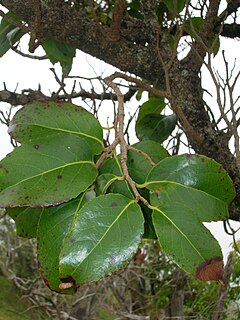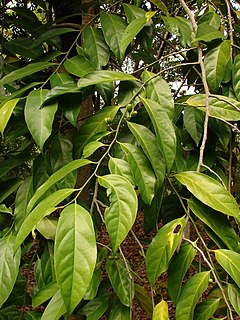
Rhododendron is a very large genus of about 1,024 species of woody plants in the heath family (Ericaceae). They can be either evergreen or deciduous. Most species are native to eastern Asia and the Himalayan region, but smaller numbers occur elsewhere in Asia, and in North America, Europe and Australia. It is the national flower of Nepal, the state flower of Washington and West Virginia in the United States, the state flower of Nagaland in India, the provincial flower of Jiangxi in China and the state tree of Sikkim and Uttarakhand in India. Most species have brightly colored flowers which bloom from late winter through to early summer.

The Salicaceae is the willow family of flowering plants. The traditional family included the willows, poplar, aspen, and cottonwoods. Genetic studies summarized by the Angiosperm Phylogeny Group (APG) have greatly expanded the circumscription of the family to contain 56 genera and about 1220 species, including the Scyphostegiaceae and many of the former Flacourtiaceae.

Xylosma is a genus of flowering plants in the family Salicaceae. It contains around 100 species of evergreen shrubs and trees commonly known as brushhollies, xylosmas, or, more ambiguously, "logwoods". The generic name is derived from the Greek words ξύλον (xylon), meaning "wood," and ὀσμή (osmé), meaning "smell," referring to the fragrant wood of some of the species. The Takhtajan system places it in the family Flacourtiaceae, which is considered defunct by the Angiosperm Phylogeny Group.

Gaultheria is a genus of about 135 species of shrubs in the family Ericaceae. The name commemorates Jean François Gaultier of Quebec, an honour bestowed by the Scandinavian Pehr Kalm in 1748 and taken up by Carl Linnaeus in his Species Plantarum. These plants are native to Asia, Australasia and North and South America. In the past, the Southern Hemisphere species were often treated as the separate genus Pernettya, but no consistent reliable morphological or genetic differences support recognition of two genera, and they are now united in the single genus Gaultheria.

Alloxylon is a genus of four species in the family Proteaceae of mainly small to medium-sized trees. They are native to the eastern coast of Australia, with one species, A. brachycarpum found in New Guinea and the Aru Islands. The genus is a relatively new creation, being split off from Oreocallis. The name is derived from Ancient Greek allo- "other" or "strange" and xylon or "wood" due to their unusual cell architecture compared with the related genera Telopea and Oreocallis. In Australia, they are known as tree waratahs due to similarities in the inflorescences between them and the closely related Telopea.

Hydnocarpus is a genus of medium to large trees in the Family Achariaceae; the genus was previously placed in the now defunct family Flacourtiaceae. Species have been recorded from Indochina, Indonesia, Malaysia and the Philippines.

Banara is a genus of flowering plants in the family Salicaceae.

Euplassa is a genus of flowering plants in the protea family. It is native to tropical South America, including Bolivia, Brazil, Colombia, Ecuador, French Guiana, Guyana, Peru, Suriname, and Venezuela.

Gomphandra is a genus of plant in family Stemonuraceae. The genus contains over 40 different species. They are dioecious trees or shrubs.

Helicia is a genus of 110 species of trees and shrubs, constituting part of the plant family Proteaceae. They grow naturally in rainforests throughout tropical South and Southeast Asia, including India, Sri Lanka, Indochina, Peninsular Malaysia to New Guinea and as far south as New South Wales.
Heliciopsis is a genus of about thirteen species of trees, constituting part of the flowering plant family Proteaceae. They grow naturally in Burma, Indo-China, SE. China, Thailand, Peninsular Malaysia, Borneo, Sumatra, Java (Indonesia) and the Philippines. The name means similar to the plant genus Helicia. Its closest relatives are Athertonia (Australia) and Virotia.
Ludia is a genus of flowering plants in the family Salicaceae.
Finschia is a genus of three recognised species of large trees, constituting part of the plant family Proteaceae. They grow naturally in New Guinea and its surrounding region, in habitats from luxuriant lowland rainforests to steep highland forests.
Catalepidia is a genus of a sole described species of medium-sized trees, constituting part of the plant family Proteaceae. The species Catalepidia heyana grows naturally only in a restricted mountain region (endemic) of the wet tropics rain forests of north-eastern Queensland, Australia. Common names include Hey's nut or Hey's nut oak.
Mayna is a genus of shrubs and trees in the family Achariaceae. It is native to the American tropics. It is dioecious, with male and female flowers produced on separate individuals.
Calantica is a genus of flowering plants in the family Salicaceae. It contains 10 species of shrubs and trees endemic to Madagascar, seven of which are threatened. Calantica is closely related to the pantropical and diverse genus Homalium, from which it differs in having a superior ovary, instead of a semi-inferior ovary. The genus is also similar to Bivinia in its superior ovary but has numerous stamens and long spiciform inflorescences.
Fittingia is a genus of flowering plants in the primrose family Primulaceae, with all species native to New Guinea. They are shrubs or small trees typically found in the understory.
Iodes is a genus of flowering plants belonging to the family Icacinaceae.
Merrilliodendron is a monotypic genus of flowering plants belonging to the family Icacinaceae. It has a synonym of PeekeliodendronSleumer. The only species is Merrilliodendron megacarpum(Hemsl.) Sleumer










